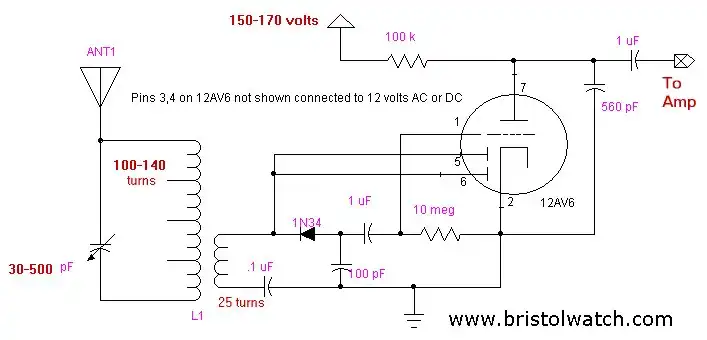
12AV6 Vacuum Tube Radio
The 12AV6 was commonly used as a detector and first audio amp in old five-tube table radios. The triode section is high gain. The 1N34A diode can be left out and the two plate electrodes (pins 5,6) will act as a detector. If pins 5, 6, and the 1N34 are left out this will act as a grid leak detector with more noise.
As shown in the video this was connected to a solid state audio amplifier based on an LM386 which will be covered on a separate page. The antenna wire I used was 20-25 feet of copper wire hung out a window to a metal pole, the ground was connected to some conduit.
The coil is hand made and one can experiment with the number of windings. This is very selective and pulled in several local stations and some of the short wave bands as well. L1 is based on a 1930s design and the purpose here is to teach some basic radio design.
For how I constructed my coils used in the video see Coils for crystal radios and for the solid-state amplifier used in the video see LM386 Amplifier.
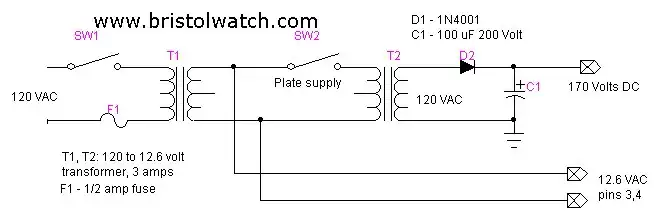
Pins 3 and 4 on the tube are the filament and require 12.6 volts AC or DC. The power supply for the plate can be 150 to 170 volts. (This is a seven pin vacuum tube.) The circuit above uses two 120 to 12.6 volt step down transformers. By connecting the two transformers "back to back" this serves to isolate the project from the power line to prevent electric shock or having a "HOT" ground.
In electronics, a vacuum tube, electron tube or thermionic valve is a device that relies on the flow of electric current through a vacuum. Vacuum tubes rely on thermionic emission of electrons from a hot filament or indirectly heated cathode that travel through a vacuum toward the anode (plate) that's held at a high positive voltage.
Additional electrodes interposed between the cathode and anode can alter the current, giving the tube the ability to amplify and switch. In the case of the 12AV6 it has only a control grid in addition to the plate and indirectly heated cathode.
The triode section is very high gain and was used in low-cost five-tube AM radios.
The two "plates" pin 5 and 6 with the cathode (pin 2) act as a dual diode.

The 3AV6, 6AV6, and 12AV6 are all identical other than filament voltage and current.
A number of these vacuum tubes are available on EBAY for ~$5.
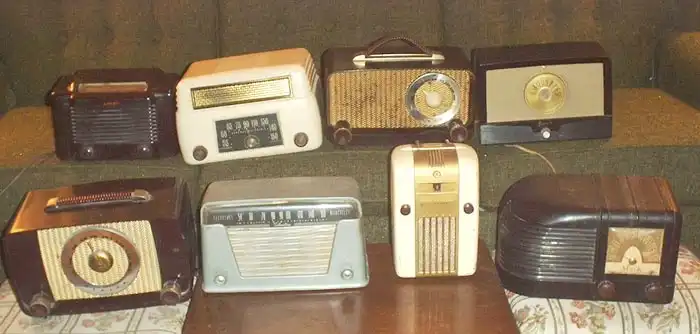
Above are typical "All American Five" vacuum tube radios built prior to 1970. The 12AV6 operated as the audio detector and 1st audio amplifier.
These were sometimes called "suicide boxes" because one side of the power line was connect to the chassis. I've repaired a number of these.
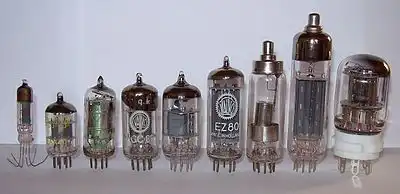
Examples of vacuum tubes.
In most applications today vacuum tubes have been replaced by solid-state devices such as transistors and other semiconductor devices. They are cheaper, more energy efficient, and last longer. I believe tubes are better as radio receivers myself due to high input impedance and they are still highly sought after in high fidelity audio amplifiers. For more on general vacuum tubes see Wikipedia
12AV6 Vacuum Tube Radio with LM386 Power Amplifier
Grid-Leak Detector Low Voltage Vacuum Tube Radio
- Build 12AV6 Vacuum Tube AM Radio
- Coils for Highly Selective Crystal Radio
- Add Push-Pull Output Stage LM386 Audio Amplifier
- Arduino Stepper Motor Drive Coil Winder
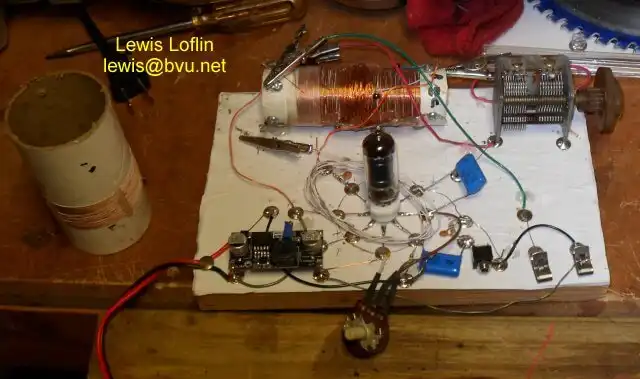
Actual constructed radio on wooden board.
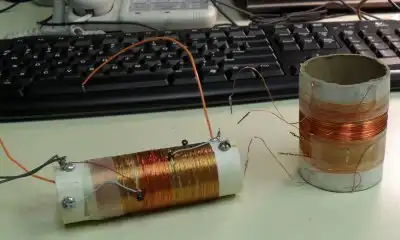
Home built radio coils.
- Quick navigation of this website:
- Basic Electronics Learning and Projects
- Basic Solid State Component Projects
- Arduino Microcontroller Projects
- Raspberry Pi Electronics, Programming
- Added Nov. 16, 2014
- ULN2003A Darlington Transistor Array with Circuit Examples
- Tutorial Using TIP120 and TIP125 Power Darlington Transistors
- Driving 2N3055-MJ2955 Power Transistors with Darlington Transistors
- Understanding Bipolar Transistor Switches
- N-Channel Power MOSFET Switching Tutorial
- P-Channel Power MOSFET Switch Tutorial
- More Power MOSFET H-Bridge Circuit Examples
- Build a High Power Transistor H-Bridge Motor Control
Web site Copyright Lewis Loflin, All rights reserved.
If using this material on another site, please provide a link back to my site.